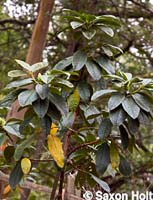Office work has been unrelenting recently, but last Saturday, with an impending storm I could no longer put off fertilizing my rhododendron garden. It began as a chore and instantly became ecstatic. O the joy! Thanks Walt Whitman.
As I walked down to the garden in the cool cloudy morning with 2 bags of fertilizer under my arms I nearly cried for joy. I almost starting skipping. My god, why have I not been in my garden these many, many weeks! There is spirit, a life in the garden that energizes and replenishes the soul. Who, reading this in a garden blog, can deny it?
My mind cleared of computer clatter, my body began to bend to garden needs, my soul was free. After a few hours my thoughts turned to sharing this joy. The camera is how I communicate and an idea took hold. A photograph may be a lie by itself but with a few words, perhaps it can reveal a few truths.
I will be attempting to do lots of things with this lengthy story. I hope my fellows here at Gardening Gone Wild will allow me to hog the floor. In 43 minutes on Dec 15, 2007 I took 31 photos. Inspired by the great nature photographer Jim Brandenburg’s phenomenal, now out of print book, Chased by the Light, I present the raw stuff of how this photographer sees.
We will look at one view of the garden and explore what types of photographs can be made. We will then go explore those ideas with closer views, I will explain the mercenary reasons I take some photos, and end up with just plain pretty pictures as I walked back to put the camera away. At the end I will post a link to all the photos.
I set my camera on a tripod to see a wide angle view of the rhododendron garden. What do we see? I will come back to this view many times:
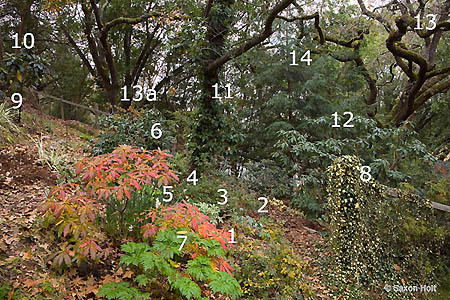
Dec 15 2007 12:17:07 PM Saxon Holt Garden Novato, CA
Well the first thing I notice is the photo is too dang small. (I need to talk to Fran, our site administrator to enlarge this blog format.) OK, notice there are 15 photo sites from this one view (There are 2 numbered 13s). I will put on a longer lens, and without moving the tripod show what I see. It might be fun to squint at this wide angle photo and wonder what there is to photograph at each number.
1. The inspiration to go and get the camera really started with the gorgeous color of my ‘Golden Comet’ azalea (Rhododendron luteum)

The theme of my Rhodo garden is fragance. Each is a fragrant specie and ‘Golden Comet’ is an unusual yellow that will take sun, and as such is on the edge of this garden away from the trees. We have had a cold fall here and I am sure this must be why there is such good fall color in the leaves. Note to myself – get more R. luteum. Note to my business – get good photos.
The fall color is the obvious photo op here, but I am garden photographer on a shoot. There is more to this story. Let’s continue to dissect this one view. Again, for the purpose of this “lesson” I am not going to move my camera, just use a longer lens. Can you see a red dot under the number 2?
2. Cyclamen persicum have started blooming.
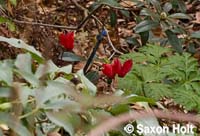
They are so easy in Zone 9, love our dry summer, and pair up nicely with the silver Hellebore x sternii foliage. Later as I investigate this closer with my camera I see the cyclamen is seeding itself. Great story to be told with my camera (to see the photo you will need on click on the weblink at the end. Am trying to keep the number of photos and their size down for the blog itself.)
3. Speaking of silver Hellebores, nothing beats ‘Janet Starnes’:

Funny how our gardening tastes evolve. I once did not care for hellebores. One would think looking at this tight photo I should have lots of them, when in fact looking at the wide garden photo you can see how the camera can lie.
4. My love of fragrant Rhododendrons starts right here. In the wide view there is even a flower blossom way back under the number 4. See the white speck ?
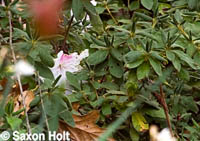
Rhododendron mucronatum is my favorite fragrance. How is that for blunt ? It is a delicate scent, some can not often smell it; and maybe somehow that is it’s powerful spell on my olifactory nerve. Delicate, crystal clean, heady and sensual it is surely Flora’s perfume. There are many more powerful Rhododendron fragrances but mucronatum was my first and remains my favorite. But in general, Rhododendon fragrance is one of those reasons to celebrate life, cast ones arms out, eyes closed, and give thanks for being human. O the joy!
5. What a great segué into my favorite flower and this particular cultiver, powerfully fragrant to boot.

It was my youngest daughter many years ago who determined daffodils to be my favorite flower and now I have thousands. This paperwhite ‘Ziva’ was the subject of an earlier blog Hooray for spring ! and is still blooming. There is no delicacy in the fragarance of paperwhites but their true glory is in how early they begin to flower, here from Halloween to New Year’s. Readers will see many more daffodil postings, my daffodil meadow is already swelling and alive.
6. Let’s point the telephoto lens now on Camellia ‘White Mermaid.
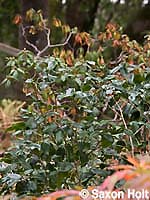
Not much of a photo from this angle but part of the story of how I make a plan-of-attack in photographing the garden. The leaves of Camellia japonica quercifolia ‘White Mermaid’ are quite distintive and I may very well be able to sell a picture of these leaves one day. Make a note to grab a macro shot of this (see in weblink gallery). Also note the distressed Rhody beyond and the subject of photo detail 13a later on.
7. More fun is the bright green weed foliage.

What would be a Gardening Gone Wild entry of this length be without some wild gardening? The accidents and happenstance of gardens are what gives them character. I allow lots of happenstance by design, letting the open spaces between my gardens and plants the luxury of wildness. (Some may call this lack of weeding and laziness) I never planted Geranium maderense in my garden, it must have snuck in in a nursery pot, but now I am letting it go. The Rhodoendron garden especially needs these big bright compound leaves as a foil to other shapes and I am delighting in “my” plant design.
8. More foliage contrasts: ‘Gold Heart’ ivy.
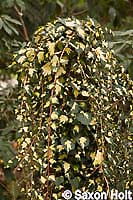
While fertilizing the garden I pulled out lots of this ivy running along looking for the moisture of my irrigation, threading it way through ferns and mulch, thinking it will strangle my Rhodies. Think twice you Hydra minded Hedera -be gone! Easy to yank now in damp December soil.
While foliage contrasts may not be vital to gardening itself, it brings great interest and accent to garden viewing and photography. In the Rhododendron garden I am always looking for foliage interest to brighten the shade and rather dark leaves. Gold Heart ivy is really cheerful and I am letting it sprawl along the ground even though the original intention was only to cover the old fence. This photo will be a winner and sell someday to somebody. Hmmm, I wonder if showing it here means it is previously published ?
9. Barely seen at the edge of the wide photo is more variegated foliage on my Iris Walk. Actually there are two clumps.
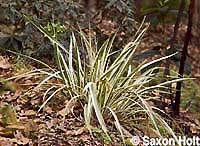
The Iris Walk (my wife’s favorite plant) comes into the Rhododendron garden as one of 2 parallel earthen paths along the hill behind my house. The lower path enters by the Gold Heart ivy. I am so delighted with this Iris pallida ‘Argentea Variegata’. It survives in the shade, with very little summer water, brightens the walk, and provides the obvious transition between gardens. A closer view is on the weblink at the end but I want to maintain the same camera position for all these photos.
An interesting observation of the garden from this location reveals a hole and need for future improvement. Look back at the wide angle view at the top of this page: through the garden, and past the Iris pallida – we see the fence. How much nicer this view would be if there were plants there, like on view down the lower path. I am adding new plants every year somewhere in my garden (aren’t we all?) but in the past couple years have been waiting for the Rhododendron garden to grow in a bit (started 9 years ago) before deciding on new additions. Now I see, revealed by this photo, that I need to hide that fence.
I have never photographed from this angle and never had to think about the garden’s visual composition in context of its end at the fence and the pathway leading toward it. The wide photo perfectly illustrates why all gardeners should photograph their own gardens. Only in the static still photo do we force ourselves to see what is really there. The camera never lies. oops did I say that?
Lets’ move a bit more quickly:
I think the Rhododendron nuttallii (10) will get big enough to hide the ugly Eucalyptus tree on my neighbor’s property but will never hide the fence as I once assumed. It is not fullsome at the ground. It is a photo op for a later day – its huge magificently crenate leaves are quite distinctive.
The climbing vine, Hydrangea seemanii (11) a gift from gardener extraordinaire Richard Hartlage, now 30 feet up in this California Bay, gives this greedy tree a reason to stay in my garden. Now I find the Hydrangea is greedy too, like ivy. Well, it is easy enough to pull out the creeping tendrils.
12. Rhododendron loderi – the king Rhody of this garden.

R. mucronatum may be the most delicate and my favorite fragance, but R. loderi is the one that gave me the bug for fragrant Rhododendrons. A huge shrub with huge flower trusses, this past spring so big the flowers themselves broke limbs when wet with spring rain. This shrub has now moved with me to three gardens.
The true kings of this garden are the oaks. O, that I could show you big pictures of this big guy. Quercus lobata, California Valley Oak:
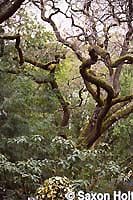
Maybe one day I will write about the oaks; I have many. This one is actually on my neighbor’s property, but I knew when I moved here that they would provide an excellent way to have a Rhododendron garden. Instant garden design.
The Valley Oaks and Live Oaks (Q. agrifolia) dominate my property in many ways, providing structure to almost every view. In the beginning, wide view of this garden you see a Live Oak on the left (above 13a). When composing the first, rather ordinary wide angle photograph where we started this lesson, the only real element of the “photographer’s eye” that makes a difference is in how I framed the oaks. They give weight, balance, and movement to the composition.
14. With so many wonderful oaks I added redwood trees.

Why did plant these true giants ?! I’m rueing the day and will take them out in a year or two. They do provide the screening I wanted in the lower garden but they get so big! Silly to think I would keep them as a tall narrow hedge..
Why is 13a a callout ? The distressed Rhody, seen in photo 6, is dying. It is part of the story of this garden that must be told, if I truly analyze our first photo. Gardens change, things don’t work out despite our best efforts, and are the most obvious editing tool I use to make the camera lie when telling a story. What we photographers edit out of the frame may tell more about the truth of a subject than what the viewer actually ends up seeing.
Well, I can finally wrap this up. A full-on photo lesson: dissecting a garden from one photo, how to tell a story with one photo. Remember, all the photos you have seen have been taken from the exact same camera position. Maybe you have been encouraged to take a few photos of your own garden to study its progress. Maybe even a few tips of composition and even maybe you have even learned what photos a professional garden photographer will take in hopes of selling them such as: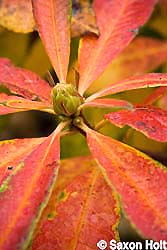
Yes, I have now moved my camera for this macro view. I take a couple more photos and walk back to put away my gear. On the way back I grab a couple more photos. Another of my sasanqua Camellias – ‘Kanjiro’
I nearly mislabeled this as ‘Cleopatra’. See my Truth in Captioning entry.
And then the 31st photo in 43 minutes, my ‘Fairmont’ Gingko
I hope this exercise was not too long for a blog. Turns out there are lots of photos to be had even on ordinary days. Who knew there was so much to say about that first view? I had fun and hope I managed to share a little joy. Joyeux Noel!
all photos A lot better quality. Gallery link live until 1.1.08. Onward.

